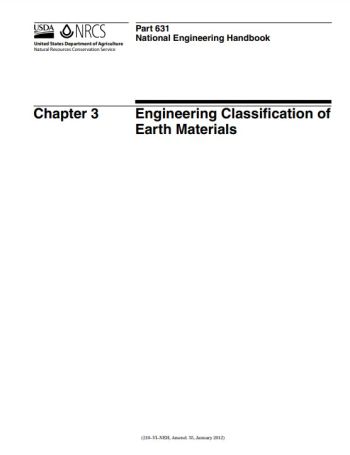National Engineering Handbook: Chapter 3 - Engineering Classification of Earth Materials
Natural Resources Conservation Service, 2012

The adequacy of a geologic investigation depends on accuracy in describing and classifying earth materials at the site and interpretations for their engineering uses. Earth materials (soil and rock) are described and classified according to their engineering or behavior properties, and their geologic and physical proper-ties. Earth materials must be classified consistently to establish correlation and stratigraphy of the site and to develop the design of the structure and construction methods to fit the site conditions. This chapter out-lines some of the more important properties of earth materials and their description and classification.
The Natural Resources Conservation Service (NRCS) geologists classify earth materials according to their physical or geological characteristics and according to their use for designing and building structures using soil and rock. The traditional geological classification emphasizes origin, mineralogy, rock classification, lithology, tectonics, and structure, including formation names. The geological classification allows correlation of soil and rock units across regions and their observed or predicted occurrence at a site. Classification of earth materials for engineering purposes uses the Unified Soil Classification System (USCS), which is based on a combination of physical and behavioral properties.
Although earth materials may be soil, rock, or combinations of soil and rock, this chapter focuses focus on soil materials. The National Engineering Handbook (NEH), part 631, chapter 4, focuses on the engineering classification of rock materials.
Some common characteristics for both soil and rock are described briefly in this chapter.
Revision ID: 5881
Revision Date: 12/16/2022
